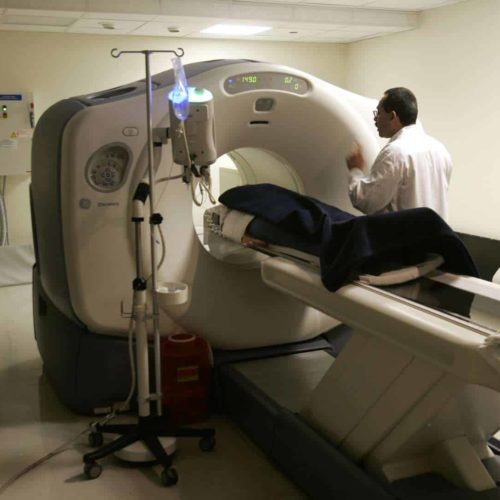Introduction
Since the September 11 terrorist attacks, Americans have been haunted by the idea that terrorist groups around the world could set off a “dirty bomb” — a simple explosive device that would scatter radioactive material to the winds, devastating a city.
Thankfully, that threat has never materialized. But the government’s watchdog is sounding alarms that terrorists looking to acquire the radioactive materials for such an attack could find them easily and unsecured at hundreds of hospitals around the country.
A report released Tuesday by General Accountability Office has found that only one out of every five hospitals that use high-risk nuclear isotopes for diagnosis and treatment have the recommended safeguards needed to secure the materials.
Over 1,500 hospitals in the U.S. use radiological sources that could be turned into dirty bombs, according to the National Nuclear Security Administration (NNSA), which shares purview over nuclear technologies with the Nuclear Regulatory Commission. NNSA has spent $105 million to upgrade security at 321 hospitals, but the agency warns it will take until 2025 to upgrade all of the hospitals on their list.
“The longer it takes to implement the security upgrades,” warns the GAO report, “the greater the risk that potentially dangerous radiological sources remain unsecured and could be used as terrorist weapons.”
The improved security features, which include enhanced security doors, increased surveillance equipment and the installation of tamper alarms, have also been slowed by the voluntary nature of the upgrades. Because the hospitals are not required to undergo these upgrades, facilities looking to cut costs can decide the security upgrades aren’t worth the expense.
So far, 14 facilities, including four in “large urban areas,” have declined to take part in the security program. The facilities that have turned down the upgrades contain an estimated 41,000 curies, a standard unit of measurement for radioactive material, which is significantly more than would be needed for a terrorist attack.
GAO inspectors found several incidents where radioactive isotopes were left unsecured and would be easily accessible to terrorists. For example, inspectors found a machine containing 2,000 curies of cesium-137, used in cancer treatments, stored on a wheeled pallet next to the loading dock at one facility, where it could easily have been wheeled down the hall and out the door. In another location, 1,500 curies of cesium-137 were kept behind a locked door — with the combination clearly written on the door frame.
As a result of the report, officials at GAO recommended that the government increase outreach to hospitals to raise awareness about the need for security upgrades, especially in highly populated urban areas. They also called for stronger NRC requirements for security, including dictating the specific placements of cameras and alarms. The GAO’s report recommended increased training for NRC inspectors, some of whom told investigators that they felt ill prepared after a week-long training course.
In a response included with the report, the Nuclear Regulatory Commission agreed that expanding outreach to more hospitals would be a good idea. But while acknowledging GAO’s recommendation for strengthening security upgrades, the NRC said that its standards are in line with those of the International Atomic Energy Agency, and argued that the security protocols would be adequate if they were followed correctly. Despite this argument, GAO stood by its recommendations.
Sen. Daniel Akaka (D-HI), who requested the report, called the findings “troubling.”
“Delays in securing these materials on the mainland U.S. unnecessarily put the American people at risk,” wrote Akaka in a statement. “We must strengthen domestic radiological security requirements and accelerate efforts to secure all medical facilities with radiological materials.”
Radioactive materials are used to help diagnose and treat a number of illnesses, including cardiac disease and cancer. Millions of procedures are performed around the country each year using nuclear medicine.
Although no dirty bomb has been used in the U.S., GAO points to an accidental explosion in Brazil that occurred in 1987 when an abandoned teletherapy machine exploded, killing four people. That device contained 1,400 curies of cesium-137. The accident and its aftermath caused about $36 million in damages to the region, according to Brazil’s government.
While acknowledging that all nuclear materials should be secured, some experts worry the focus on dirty bombs obscures the danger presented by the use of highly-enriched uranium in medical devices. Rather than a small improvised explosive, HEU could be used to make a bomb on the scale of those used in Hiroshima and Nagasaki.
“Dirty bombs are weapons of mass distraction, not weapons of mass destruction,” says Alan J. Kupperman, who heads the Nuclear Proliferation Prevention Project at the University of Texas. “By contrast, a nuclear weapon from stolen HEU could kill tens of thousands of people.”
Kupperman and others have pushed Congress to move on the American Medical Isotopes Production Act, which was passed by the House in 2011. However, the House version leaves open a potentially dangerous loophole, as reported by the Center earlier this year. An international treaty, signed in April, has also been criticized for not going far enough to restrict the use of highly enriched uranium in medical isotopes.
On Wednesday, the House Armed Services Committee held a hearing on security at nuclear power plants after a trio of activists, including an 82-year-old nun, broke into a sensitive facility outside Knoxville, Tenn.


Join the conversation
Show Comments